Gemini Alarm/ immobiliser issue
Discussion
Evening all,
I'll say at the outset that electrics is not my strong suit - somewhere between novice and amateur.
My 94 griff 500 has developed an odd fault. unlock the car, key in the ignition, turn to on - all fine, except no power to the ECU. The engine cranks well, but as the ECU controls the fuel pump etc etc , it doesn't fire.
About 30 seconds after ignition on, the ECU light comes on, fuel pump primes and off we go. if, once the first ignition on eventually powers the ECU, I turn the car off and on again there is still a delay powering the ECU, but its shorter in duration 5-10 seconds, maybe less.
I have a Canems set up, so no relays in the loom specifically for fuel pump. I've had the stereo and vents out and found the alarm/immobiliser. I'm not that fussed to keep it because I have a battery brain I can trigger remotely, and a battery in the boot so pretty good immobilization options anyway
Any suggestions what tests I can run to see where the problem might be?
Can i bypass the system to just power the ECU whenever the i turn the ignition on?
Thanks in advance, appreciate this topic has been covered a few times on PH, but i cant find anything for Gemini rather than Meta
I'll say at the outset that electrics is not my strong suit - somewhere between novice and amateur.
My 94 griff 500 has developed an odd fault. unlock the car, key in the ignition, turn to on - all fine, except no power to the ECU. The engine cranks well, but as the ECU controls the fuel pump etc etc , it doesn't fire.
About 30 seconds after ignition on, the ECU light comes on, fuel pump primes and off we go. if, once the first ignition on eventually powers the ECU, I turn the car off and on again there is still a delay powering the ECU, but its shorter in duration 5-10 seconds, maybe less.
I have a Canems set up, so no relays in the loom specifically for fuel pump. I've had the stereo and vents out and found the alarm/immobiliser. I'm not that fussed to keep it because I have a battery brain I can trigger remotely, and a battery in the boot so pretty good immobilization options anyway
Any suggestions what tests I can run to see where the problem might be?
Can i bypass the system to just power the ECU whenever the i turn the ignition on?
Thanks in advance, appreciate this topic has been covered a few times on PH, but i cant find anything for Gemini rather than Meta
If you have a Canems instalation you do have a fuel pump relay, well I do anyway, and don't just assume your issue is the immobiliser as I've had a number of breakdowns relating to the way my Canems system was installed and the cheap components used. The common immobiliser issues normally relate to the incorrect way TVR wired the Meta system used from around late 1995 or maybe early 1996.
Perhaps they wired the earlier Gemini system badly too which is quite possible with TVR's wiring standards but the Meta system was definitely wired back to front, saying that the problem this causes normally relates to the starter motor circuit not the ECU circuit which in turn controls the fuel pump, anyway there's a lot to check before you assume it's an immobiliser issue.
In my Canems instalation there's a relay named EMS (Engine Management System) which is misleading because I can completely remove this relay and the LED light on the ECU still comes on when I cycle the ignition key, however when removed it disables the fuel pump so dispite being labelled EMS on my instalation it's definitely the fuel pump relay
As a quick test, I recommend removing this relay......
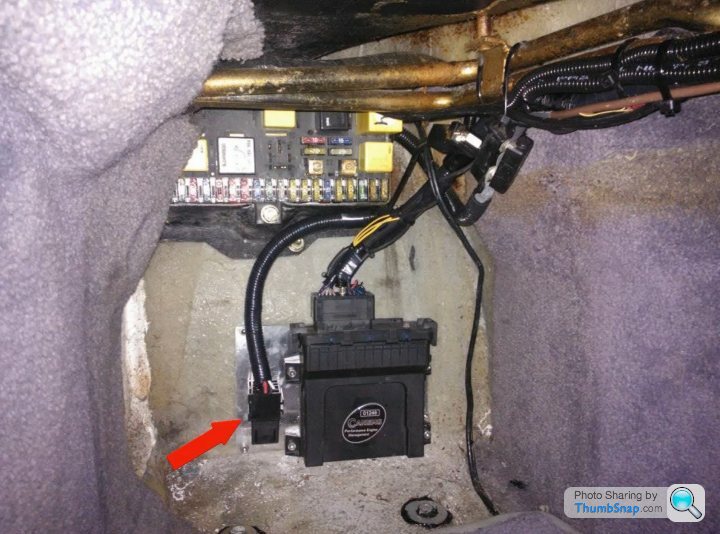
Now cyle the ignition key and look to see if the LED still illuminates on your Canems ECU, if it's wired like mine the LED will come on but the fuel pump will be disabled.
In my case the above relay is wired so the ECU provides the low amp trigger to terminal 86, with terminal 30 supplying the high amp feed to the fuel pump, I had this relay fail on me on my way down to Le Mans one year so had to bypass it. I can only assume a poor quality relay had been used as it was only two years old at the time, as I was stranded at the side of the road and had no spare relay to get car going I was forced to fit a manual switch to turn the fuel pump on & off.
On my Canems instalation the high amp supply from the battery to this wrongly named relay (terminal 87) is fused, the installers had used this type of waterproof fuse holder.
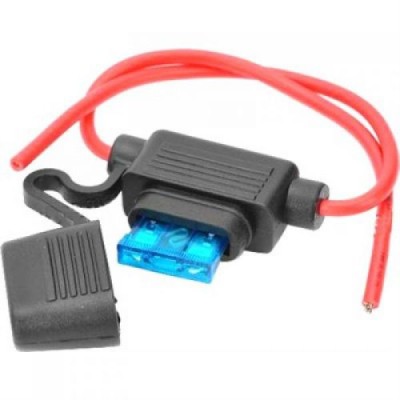
These cheap Chinese waterproof fuse holders were also used for my two rad fans so I had three in total, two of which have failed on me so they're not to be trusted, the waterproof fuse holder supplying one of the fans failed first but a year later the one supplying the so called EMS relay (actually the fuel pump relay) failed on me too causing yet another breakdown
I found this which looked suspicious...
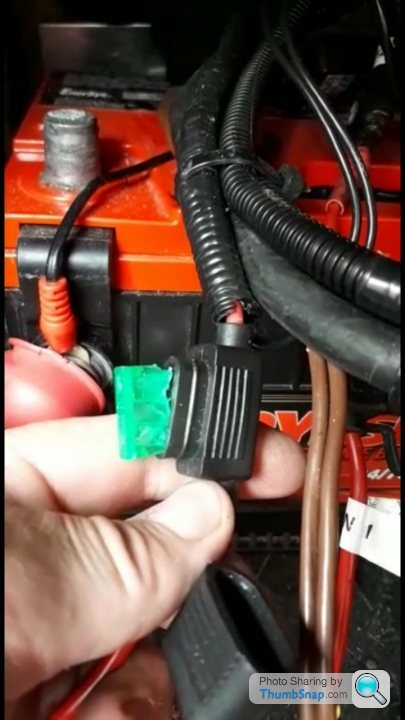
Clearly the insulation around the fuse had been melting!
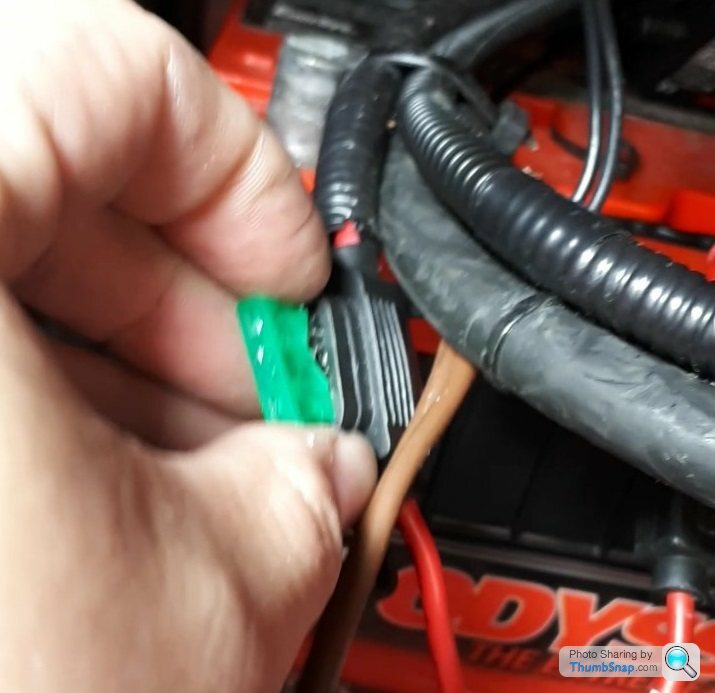
When I tried to pull out the fuse the insulation came away in my hand.
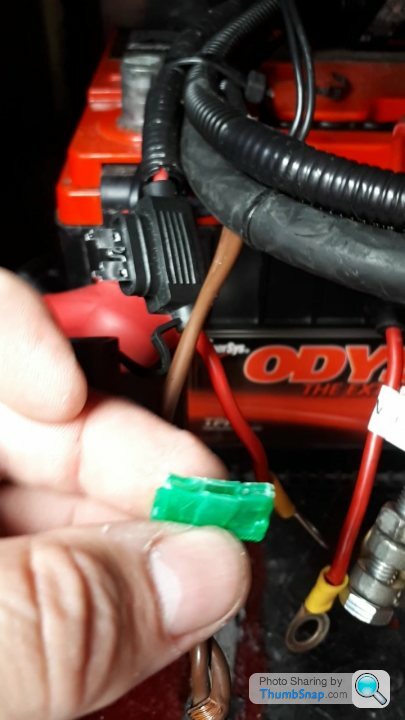
Stranded yet again at the side of the road I got my test meter out and found while there was 12v on the battery side of the fuse holder but dispite the fuse element remaining intact there was no voltage on the relay side of the fuse holder, clearly it had failed internally and had been on the way out for some time which had caused the heat that had melted the fuse insalation.
So I opened up the suspect fuse holder and found this inside....
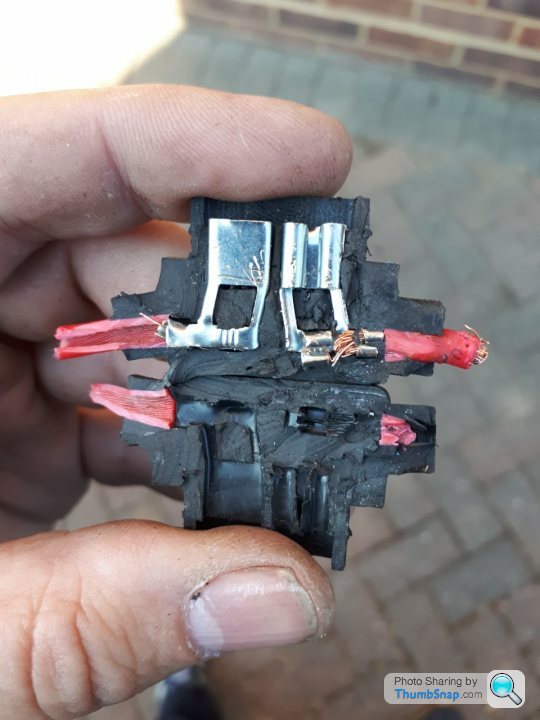
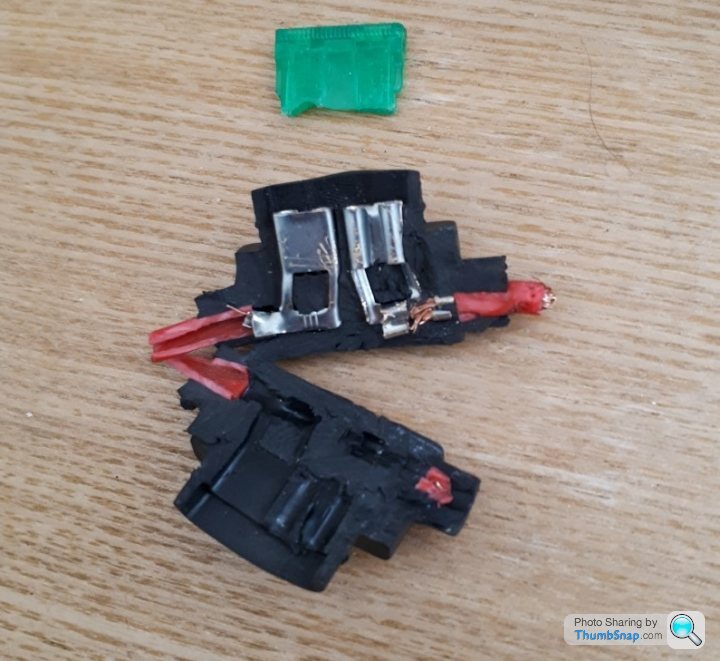
I also recomend replacing your MAP sensor with a better quality one, the one originally used on my Canems instalation was very poor quality, I replaced it with a Japanese quality MAP sensor from NTK and the car was transormed, you want this one (NTK 92477) which is a a far superior quality sensor than the one I originally got with my Canems instalation...

Clearly there had always been resolution issues with the original cheap no name MAP sensor used because as soon as I replaced it with the above NTK 92477 sensor the hesistation issue that had pluaged the car from day one vanished and the engine became imeasurably smoother, I also recomend relocating the MAP sensor as it gets soaked in wet weather where the installers choose to place it.

In addition to the above I've suffered an idle valve failure as the one used by the installers was a cheap Bosch copy, again it was presumably chosen to keep costs down but this strategy has consistantly proved itself to be a false economy as reliability and the my faith in the system suffered badly. The solution to my idle valve issues was simply to remove the poor quality Chinese no name unit as supplied with my Canems installation and replace it with something better.
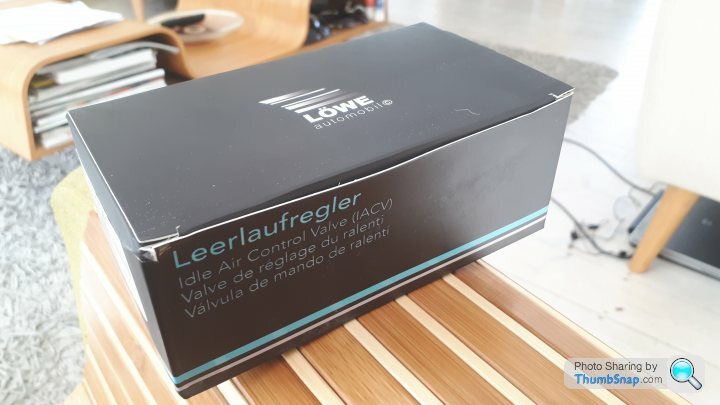
As you can see I didn't buy a Bosch original either, but I did select a quality German made copy from Lowe which is way better than the other rubish you find on ebay, I purchased it for £50 direct from the factory in Berlin including delivery to me here in the UK and it works perfectly. I suspect the installers may have learnt their lesson by now but as an early adopter I definitely paid the price for a policy of cost cutting, in the end I was forced to trace and fix all the problems myself which was disapointing.
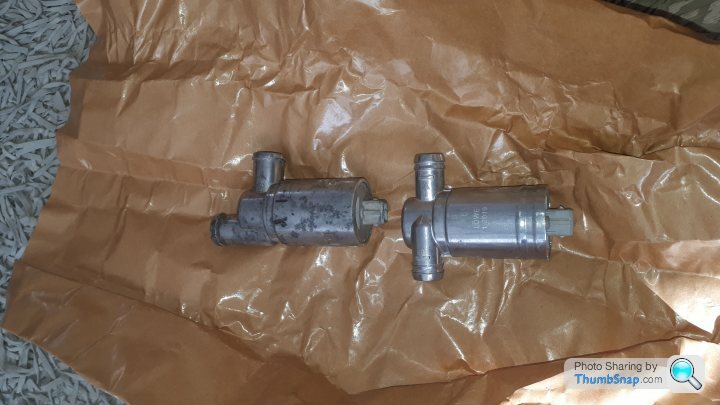
As shown in the above image I also went with the above parallel hose fitting design rather than the 90 degree type used by the installers as it allows for a far neater installation.
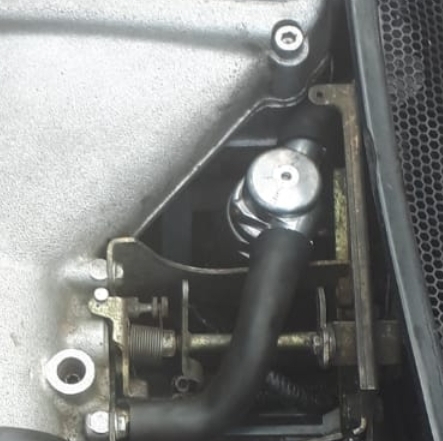
I could also go on to cover the multiple ECU failures I've suffered over the years, I've had at least four ECU meltdowns so we don't have space for all that saga here but I can tell you I have subsiquently uncovered other Canems instalation wiring gaffs which I believe were part of the reason my ECUs kept blowing the injector drivers off the board. All these wiring issues and the use of poor quality components to keep the cost of the instalation down were a real pain but sadly the ECUs themselves came with their own issues too as it seems early Canems ECUs were all hand soldered. Newer Canems ECUs have proper robot soldered boards which solved a multitude of issues, I believe if you find you have one of these hand soldered hash ups the installers will exchange it for a newer robot soldered item free of charge, but you will be required to return your old ECU which I can only assume is an attempt to bury the problem by removing these hand soldered ECUs from circulation.
I will send you my immobiliser bypass instructions but as you can see with the Canems instalation there are other elemets that need checking too, if your fuel pump isnt coming on is your ECU triggering that relay?, and if it is delivering the trigger voltage to terminal 86 of the relay is the fuse holder consistantly alowing the high amp +12v battery supply through it (terminal 87 to 30)?. The poor quality relay and cheap Chinese waterproof fuse holders were in my case the source of just two of the many breakdowns I've suffered since converting to Canems, the cheap poor quality MAP sensor and idle valve just made the engine run poorly but these were still frustrating issues to solve and it could have all been avoided if the installers had just used better components that I've actually proved don't actually cost much more than the junk parts originally used on my car.
Wiring gaffs such as taking the ground for the light in my LPG switch from the same ECU ground that switches maps/fuels was even more disaponting as it caused a serious earth loop that had safety consiquences, an earth loop the installers themselves failed to fix when given the oportunity so that was another issue I ended up tracing and solving myself. But it was the multiple ECU failures that really disapointed me, overall rather than improving the reliability of my TVR, my Canems instalation actually made it worse, the reality is I never had such issues with the Lucas 14CUX.
Back to your intermittent fuel pump issue it's important to understand from the factory TVR wired the immobiliser to switch in a +12v supply to two circuits, the first being the Lucas 14CUX ECU which in turn triggers the fuel pump relay hanging in the footwell, the second being for the far higher amp starter solenoid (no dedicated relay used). The problem is potted deep within the Meta immobiliser there are two micro relays swiching in these circuits, there's a higher amp one for the starter solenoid and a lower rated one intended for the ECU. Unfortunately TVR in their wisdom wired the ECU through the high amp Meta relay and the starter solenoid through the low amp Meta relay which then fails causing the hot start (no cranking) issue, its actually unusual for the ECU Meta relay to fail because the way TVR wired it this relay is actually over specified for the job so I wouldnt jump to the conclusion your issue is immobiliser related.
In theory your Canems should be wired in the same, however don't just assume it is, for example just because your Canems relay is labelled EMS don't just assume it's an ECU relay, when tested you may find its actually a fuel pump relay (as it is with mine) and like me you may not even have a dedicated ECU relay. That relay may be a cheap poor quality item as I suffered so it may be on the way out, or it could easily be the nasty waterproof fuse holder is failing internally, both of which could easily cause an intermittent supply to your fuel pump.
So based on bitter experience of my Canems instalation my best advice is to test all the circuits yourself with a multimeter to prove how its actually been intalled, get a decent quality relay in there and remove all those nasty failure prone fuse holders that rather than protecting your wiring are actually a potential fire risk. After all that if your fuel pump is still suffering intermittent supply issues you need to check the connection at the fuel pump itself which is prone to corrosion, and the multi plug connector hidden behind the flap of carpet behind the passenger seat which is also a known point of poor fule pump supply.
Only after satisfying yourself all these elements are not your issue should you progress to bypassing your immobiliser, do this by following the instructions I'm about to send you as a response to the PM you sent me yesterday.
Dave.
Perhaps they wired the earlier Gemini system badly too which is quite possible with TVR's wiring standards but the Meta system was definitely wired back to front, saying that the problem this causes normally relates to the starter motor circuit not the ECU circuit which in turn controls the fuel pump, anyway there's a lot to check before you assume it's an immobiliser issue.
In my Canems instalation there's a relay named EMS (Engine Management System) which is misleading because I can completely remove this relay and the LED light on the ECU still comes on when I cycle the ignition key, however when removed it disables the fuel pump so dispite being labelled EMS on my instalation it's definitely the fuel pump relay

As a quick test, I recommend removing this relay......

Now cyle the ignition key and look to see if the LED still illuminates on your Canems ECU, if it's wired like mine the LED will come on but the fuel pump will be disabled.
In my case the above relay is wired so the ECU provides the low amp trigger to terminal 86, with terminal 30 supplying the high amp feed to the fuel pump, I had this relay fail on me on my way down to Le Mans one year so had to bypass it. I can only assume a poor quality relay had been used as it was only two years old at the time, as I was stranded at the side of the road and had no spare relay to get car going I was forced to fit a manual switch to turn the fuel pump on & off.
On my Canems instalation the high amp supply from the battery to this wrongly named relay (terminal 87) is fused, the installers had used this type of waterproof fuse holder.

These cheap Chinese waterproof fuse holders were also used for my two rad fans so I had three in total, two of which have failed on me so they're not to be trusted, the waterproof fuse holder supplying one of the fans failed first but a year later the one supplying the so called EMS relay (actually the fuel pump relay) failed on me too causing yet another breakdown

I found this which looked suspicious...

Clearly the insulation around the fuse had been melting!

When I tried to pull out the fuse the insulation came away in my hand.

Stranded yet again at the side of the road I got my test meter out and found while there was 12v on the battery side of the fuse holder but dispite the fuse element remaining intact there was no voltage on the relay side of the fuse holder, clearly it had failed internally and had been on the way out for some time which had caused the heat that had melted the fuse insalation.
So I opened up the suspect fuse holder and found this inside....


I also recomend replacing your MAP sensor with a better quality one, the one originally used on my Canems instalation was very poor quality, I replaced it with a Japanese quality MAP sensor from NTK and the car was transormed, you want this one (NTK 92477) which is a a far superior quality sensor than the one I originally got with my Canems instalation...

Clearly there had always been resolution issues with the original cheap no name MAP sensor used because as soon as I replaced it with the above NTK 92477 sensor the hesistation issue that had pluaged the car from day one vanished and the engine became imeasurably smoother, I also recomend relocating the MAP sensor as it gets soaked in wet weather where the installers choose to place it.

In addition to the above I've suffered an idle valve failure as the one used by the installers was a cheap Bosch copy, again it was presumably chosen to keep costs down but this strategy has consistantly proved itself to be a false economy as reliability and the my faith in the system suffered badly. The solution to my idle valve issues was simply to remove the poor quality Chinese no name unit as supplied with my Canems installation and replace it with something better.

As you can see I didn't buy a Bosch original either, but I did select a quality German made copy from Lowe which is way better than the other rubish you find on ebay, I purchased it for £50 direct from the factory in Berlin including delivery to me here in the UK and it works perfectly. I suspect the installers may have learnt their lesson by now but as an early adopter I definitely paid the price for a policy of cost cutting, in the end I was forced to trace and fix all the problems myself which was disapointing.

As shown in the above image I also went with the above parallel hose fitting design rather than the 90 degree type used by the installers as it allows for a far neater installation.

I could also go on to cover the multiple ECU failures I've suffered over the years, I've had at least four ECU meltdowns so we don't have space for all that saga here but I can tell you I have subsiquently uncovered other Canems instalation wiring gaffs which I believe were part of the reason my ECUs kept blowing the injector drivers off the board. All these wiring issues and the use of poor quality components to keep the cost of the instalation down were a real pain but sadly the ECUs themselves came with their own issues too as it seems early Canems ECUs were all hand soldered. Newer Canems ECUs have proper robot soldered boards which solved a multitude of issues, I believe if you find you have one of these hand soldered hash ups the installers will exchange it for a newer robot soldered item free of charge, but you will be required to return your old ECU which I can only assume is an attempt to bury the problem by removing these hand soldered ECUs from circulation.
I will send you my immobiliser bypass instructions but as you can see with the Canems instalation there are other elemets that need checking too, if your fuel pump isnt coming on is your ECU triggering that relay?, and if it is delivering the trigger voltage to terminal 86 of the relay is the fuse holder consistantly alowing the high amp +12v battery supply through it (terminal 87 to 30)?. The poor quality relay and cheap Chinese waterproof fuse holders were in my case the source of just two of the many breakdowns I've suffered since converting to Canems, the cheap poor quality MAP sensor and idle valve just made the engine run poorly but these were still frustrating issues to solve and it could have all been avoided if the installers had just used better components that I've actually proved don't actually cost much more than the junk parts originally used on my car.
Wiring gaffs such as taking the ground for the light in my LPG switch from the same ECU ground that switches maps/fuels was even more disaponting as it caused a serious earth loop that had safety consiquences, an earth loop the installers themselves failed to fix when given the oportunity so that was another issue I ended up tracing and solving myself. But it was the multiple ECU failures that really disapointed me, overall rather than improving the reliability of my TVR, my Canems instalation actually made it worse, the reality is I never had such issues with the Lucas 14CUX.
Back to your intermittent fuel pump issue it's important to understand from the factory TVR wired the immobiliser to switch in a +12v supply to two circuits, the first being the Lucas 14CUX ECU which in turn triggers the fuel pump relay hanging in the footwell, the second being for the far higher amp starter solenoid (no dedicated relay used). The problem is potted deep within the Meta immobiliser there are two micro relays swiching in these circuits, there's a higher amp one for the starter solenoid and a lower rated one intended for the ECU. Unfortunately TVR in their wisdom wired the ECU through the high amp Meta relay and the starter solenoid through the low amp Meta relay which then fails causing the hot start (no cranking) issue, its actually unusual for the ECU Meta relay to fail because the way TVR wired it this relay is actually over specified for the job so I wouldnt jump to the conclusion your issue is immobiliser related.
In theory your Canems should be wired in the same, however don't just assume it is, for example just because your Canems relay is labelled EMS don't just assume it's an ECU relay, when tested you may find its actually a fuel pump relay (as it is with mine) and like me you may not even have a dedicated ECU relay. That relay may be a cheap poor quality item as I suffered so it may be on the way out, or it could easily be the nasty waterproof fuse holder is failing internally, both of which could easily cause an intermittent supply to your fuel pump.
So based on bitter experience of my Canems instalation my best advice is to test all the circuits yourself with a multimeter to prove how its actually been intalled, get a decent quality relay in there and remove all those nasty failure prone fuse holders that rather than protecting your wiring are actually a potential fire risk. After all that if your fuel pump is still suffering intermittent supply issues you need to check the connection at the fuel pump itself which is prone to corrosion, and the multi plug connector hidden behind the flap of carpet behind the passenger seat which is also a known point of poor fule pump supply.
Only after satisfying yourself all these elements are not your issue should you progress to bypassing your immobiliser, do this by following the instructions I'm about to send you as a response to the PM you sent me yesterday.
Dave.
Dave,
Thank you so much for your reply and email, I have replied.
I will go and cross check my components against the list you supplied, reliability is key to me (and a big part of why I did the install in the first place) as this is my daily driver.
Further investigation last night and it appears the fault is not with the fuel pump, but with the power supply to the ECU. When I first turn the ignition on the ECU takes about 3 mins to get power. If I turn the ignition off and back on again, it take less, maybe 10-30 seconds to get power. If I then leave it a few hours the delay between switching the ignition on and the ECU getting power is back up to 2-3 mins.
Am I about to go on fire?!
Thank you so much for your reply and email, I have replied.
I will go and cross check my components against the list you supplied, reliability is key to me (and a big part of why I did the install in the first place) as this is my daily driver.
Further investigation last night and it appears the fault is not with the fuel pump, but with the power supply to the ECU. When I first turn the ignition on the ECU takes about 3 mins to get power. If I turn the ignition off and back on again, it take less, maybe 10-30 seconds to get power. If I then leave it a few hours the delay between switching the ignition on and the ECU getting power is back up to 2-3 mins.
Am I about to go on fire?!
Hi Chris,
You are not alone, an improvement in reliability is one of the key reasons for people to replace the Lucas ECU. One of the advantages is meant to be a lot of the poor quality TVR wiring gets removed in the process, if the installers use the same original TVR live feed for the ECU they've really fallen at the first hurdle
You need to establish how your ECU recieves its +12v supply and it should be via a relay, if there is no true dedicated ECU relay then fit one, keep in mind if you remove the Canems relay and the ECU light still comes on when you turn your ignition on it can't possibly be a true ECU relay!
Worse still if the +12v supply to the ECU still passes through your 24 year ond Gemini immobiliser the whole engine management instalation will only ever be as reliable as your ancient security system. If you're offering proffesional engine management installations to the general public and claiming it improves reliability, to me it makes no sense to trust the entire reliability of everything your fitting to a +12v supply that passes through and is switched by a 24 year old immobiliser!
PM sent with additional advice.
Dave.
You are not alone, an improvement in reliability is one of the key reasons for people to replace the Lucas ECU. One of the advantages is meant to be a lot of the poor quality TVR wiring gets removed in the process, if the installers use the same original TVR live feed for the ECU they've really fallen at the first hurdle

You need to establish how your ECU recieves its +12v supply and it should be via a relay, if there is no true dedicated ECU relay then fit one, keep in mind if you remove the Canems relay and the ECU light still comes on when you turn your ignition on it can't possibly be a true ECU relay!
Worse still if the +12v supply to the ECU still passes through your 24 year ond Gemini immobiliser the whole engine management instalation will only ever be as reliable as your ancient security system. If you're offering proffesional engine management installations to the general public and claiming it improves reliability, to me it makes no sense to trust the entire reliability of everything your fitting to a +12v supply that passes through and is switched by a 24 year old immobiliser!
PM sent with additional advice.
Dave.
If there is an ECU supply relay in the circuit....There should be
During the circuit fail state
Check for good battery +ive @ relay terminal 30
Check for good battery -ive @ relay terminal 85
Check for good ignition switched +ive @ relay terminal 86
If all above check out good
Now check that relay is switching +ive to terminal 87
These checks may point to what's failing
If all above check out good
Now is the time to further check through the circuit to find out why the output from relay terminal 87 isn't getting as far as the ECU
The chances are that a bad connection or failing immobiliser will be the cause
During the circuit fail state
Check for good battery +ive @ relay terminal 30
Check for good battery -ive @ relay terminal 85
Check for good ignition switched +ive @ relay terminal 86
If all above check out good
Now check that relay is switching +ive to terminal 87
These checks may point to what's failing
If all above check out good
Now is the time to further check through the circuit to find out why the output from relay terminal 87 isn't getting as far as the ECU
The chances are that a bad connection or failing immobiliser will be the cause
If there was a place TVR would hide a relay for switching power to the ECU, where would they hide it?
In the garage at the minute and I have a red and white wire, plus earth, from the ignition barrel heading into a loom and disappearing down the footwell, door side.
The white wire has some damage and exposed wire, but I'll fix that and at the moment those areas are hanging in free space.
1.5v at the red wire with ignition off, white wire then gets 1.5v with ignition on (nothing when its off).
where to these wires normally reappear so I can test resistance/voltage drop?
Thanks
In the garage at the minute and I have a red and white wire, plus earth, from the ignition barrel heading into a loom and disappearing down the footwell, door side.
The white wire has some damage and exposed wire, but I'll fix that and at the moment those areas are hanging in free space.
1.5v at the red wire with ignition off, white wire then gets 1.5v with ignition on (nothing when its off).
where to these wires normally reappear so I can test resistance/voltage drop?
Thanks
See here http://www.bertram-hill.com/tvr-griffith-ignition....
The thing is, you commented engine cranks when supply is missing from ECU
Engine won't crank with 1.5 Volts at ignition switch Red Cable main +ive supply
The thing is, you commented engine cranks when supply is missing from ECU
Engine won't crank with 1.5 Volts at ignition switch Red Cable main +ive supply
There is also a panel, behind the dashboard itself with 4 relays on it. No mention of what these are in the handbook?
I also pull fuse number 2 from the fuse board which is supposedly "battery feed to ECU" and when turning on ignition still managed to, after the now usual delay, get power to the ECU.
I'm sure once I get started I'll figure it out, but following a loom behind the dash is impossible.
Do I need to take the dash out?!
I also pull fuse number 2 from the fuse board which is supposedly "battery feed to ECU" and when turning on ignition still managed to, after the now usual delay, get power to the ECU.
I'm sure once I get started I'll figure it out, but following a loom behind the dash is impossible.
Do I need to take the dash out?!
Thanks Penelope,
Yeah 1.5v seems low, my gauge in the dash says I have 12.5v. should that be the same at the ignition? Doesn't change when the ECU springs to life - I just figured there was a relay to switch the ECU power on when ignition was engaged.
Finding it is proving impossible - there is nothing I can see through the stereo slot in the dash, or the footwells, other than this mysterious panel of 4 relays?
thanks - I did say I was a novice!
Yeah 1.5v seems low, my gauge in the dash says I have 12.5v. should that be the same at the ignition? Doesn't change when the ECU springs to life - I just figured there was a relay to switch the ECU power on when ignition was engaged.
Finding it is proving impossible - there is nothing I can see through the stereo slot in the dash, or the footwells, other than this mysterious panel of 4 relays?
thanks - I did say I was a novice!
Little_Blue_Car said:
Thanks for the link. Fuse 12 does isolate power the the ECU. I pulled it and the ECU didn't come on after 5-10 mins. popped it back in and it came on with the same delay.
Interestingly my fuse 21 slot is empty? (interestingly probably not the right word).
Firstly fuse 21 slot should not be empty, on my 1996 Chimaera this is listed as 'battery supply to ignition', its a 25a fuse, try fitting one and see what happens.Interestingly my fuse 21 slot is empty? (interestingly probably not the right word).
My Canems ECU is also fused through the board like yours although this may be a lucky accident rather than by direct design or the ECU installers surely would have mentioned it, which they didnt. I have a feeling it's also fuse 12 which from memory is 'engine/central door locking', 'engine' may be referring descretely to the live feed for the immobiliser which would make sense based on the results of your tests.
The installers really should be telling their customers this when they pick up the car after an ECU change and adding a note to their fuse board diagram page in their owners handbook. If the Canems ECU suddendly loses power customers need to know where to look for a blown fuse in the board, I had to find the fuse myself by pulling fuses as you did, clearly this is a less than ideal situation.
I would simplify things and just give Canems ECU pin 3B a +12v supply via an ignition switched fused relay, look for the white wire at the ECU connector. This way you'll be bypassing everything on the existing live feed to the ECU including the immobiliser, the delay problem will be resolved and you'll have a new and safe feed to the ECU that you actually understand and can trust.
Starting with the way the original 14CUX is wired, pin out numer 16 in the middle row on the Lucas ECU connector is the fuel pump relay trigger, its a blue/purple wire. This fuel pump trigger wire is not directly immobilised, it doesnt need to be as it's actually the ECU that turns the fuel pump on and off so logic dictates imobilisation takes place on the +12v feed to the ECU itself via fuse 12.
On the Canems system it seems the same +12v supply feed used for the original Lucas 14CUX ECU is reused to power up the new Canems ECU, this explains why the Canems ECU can be disabled by pulling fuse 12. It appears the istallers simply take the brown wire that originally supplied the 14CUX ECU at pin 15 and connect it to pin 3B on the Canems ECU.
Why a dedicated ECU relay is not retained within this circuit as per the original wiring is not clear, surely it would be best practice to do so...
ECU relay or no ECU relay asside wiring the Canems ECU this way does at least mean that fuse 12 is still being used to protect the new ECU, but it also means any immobilisation system TVR originally included on that circuit is also retained. Clearly this also means any immobiliser faults present in the 24 year old security system will be atomatically carried over to the newly Canems equiped car
As immobilisation occurs on the ECU circuit the way the fuel pump is wired is of less relevance to the OP and the delay he's experiencing in getting power to his ECU (and so the fuel pump) does seem likely to be immobiliser related, however its still helpful to understand on the Canems instalation the original Lucas 14CUX fuel pump relay is effectively replaced by what is reffered to in the Canems manual as the 'Main Relay'... as seen below.

This 'Main Relay' has been labelled EMS (Engine Management System) on my car which is confusing, as it turns out it's not actually a replacement for the Lucas ECU relay as the labelling might suggest but is definitely acting as a fuel pump relay. Both I and the OP have proved this by removing it, when the ignition is turned on with this so called 'Main Relay' (or 'EMS Relay' in my case) is removed the LED on the Canems ECU still illuminates but power is no longer supplied to the fuel pump.
To test the theory that the immobiliser is causing the delay in supplying +12v to his ECU the OP needs to temporarily bypass it, although my bypass instruction are intended for the Meta system the principles are just the same so a little time with a test meter will easily identify the correct circuits. Be aware black coloured wire is normally used on these circuits in a bid to confuse a potential car theif, so you will need to use a multimeter to identify them correctly.
The OP should always keep in mind an immobiliser is just an interupter switch turned on and off with an IR key fob, so if the suspect circuit is run around the immobiliser it will be bypassed, and completly removing the immobiliser from the circuit will soon tell the OP if it's genuinely the source of his issue.
This also means as the immobiliser is just an interupter switch it can easily be replaced with a simple latching switch, a switch that can be hidden in a location only known to the OP.
On the Canems system it seems the same +12v supply feed used for the original Lucas 14CUX ECU is reused to power up the new Canems ECU, this explains why the Canems ECU can be disabled by pulling fuse 12. It appears the istallers simply take the brown wire that originally supplied the 14CUX ECU at pin 15 and connect it to pin 3B on the Canems ECU.
Why a dedicated ECU relay is not retained within this circuit as per the original wiring is not clear, surely it would be best practice to do so...

ECU relay or no ECU relay asside wiring the Canems ECU this way does at least mean that fuse 12 is still being used to protect the new ECU, but it also means any immobilisation system TVR originally included on that circuit is also retained. Clearly this also means any immobiliser faults present in the 24 year old security system will be atomatically carried over to the newly Canems equiped car

As immobilisation occurs on the ECU circuit the way the fuel pump is wired is of less relevance to the OP and the delay he's experiencing in getting power to his ECU (and so the fuel pump) does seem likely to be immobiliser related, however its still helpful to understand on the Canems instalation the original Lucas 14CUX fuel pump relay is effectively replaced by what is reffered to in the Canems manual as the 'Main Relay'... as seen below.

This 'Main Relay' has been labelled EMS (Engine Management System) on my car which is confusing, as it turns out it's not actually a replacement for the Lucas ECU relay as the labelling might suggest but is definitely acting as a fuel pump relay. Both I and the OP have proved this by removing it, when the ignition is turned on with this so called 'Main Relay' (or 'EMS Relay' in my case) is removed the LED on the Canems ECU still illuminates but power is no longer supplied to the fuel pump.
To test the theory that the immobiliser is causing the delay in supplying +12v to his ECU the OP needs to temporarily bypass it, although my bypass instruction are intended for the Meta system the principles are just the same so a little time with a test meter will easily identify the correct circuits. Be aware black coloured wire is normally used on these circuits in a bid to confuse a potential car theif, so you will need to use a multimeter to identify them correctly.
The OP should always keep in mind an immobiliser is just an interupter switch turned on and off with an IR key fob, so if the suspect circuit is run around the immobiliser it will be bypassed, and completly removing the immobiliser from the circuit will soon tell the OP if it's genuinely the source of his issue.
This also means as the immobiliser is just an interupter switch it can easily be replaced with a simple latching switch, a switch that can be hidden in a location only known to the OP.

Little_Blue_Car said:
Thanks Penelope,
Yeah 1.5v seems low, my gauge in the dash says I have 12.5v. should that be the same at the ignition? Doesn't change when the ECU springs to life - I just figured there was a relay to switch the ECU power on when ignition was engaged.
Finding it is proving impossible - there is nothing I can see through the stereo slot in the dash, or the footwells, other than this mysterious panel of 4 relays?
thanks - I did say I was a novice!
Novice, nothing wrong with being a noviceYeah 1.5v seems low, my gauge in the dash says I have 12.5v. should that be the same at the ignition? Doesn't change when the ECU springs to life - I just figured there was a relay to switch the ECU power on when ignition was engaged.
Finding it is proving impossible - there is nothing I can see through the stereo slot in the dash, or the footwells, other than this mysterious panel of 4 relays?
thanks - I did say I was a novice!
1.5 Volts won't activate a 12 volt relay to power the ECU and won't activate a starter relay if fitted
Don't know how anything can possibly work when there is only 1.5 Volts at the ignition switch supply
Yet the engine cranks over with the starter motor
Wonder if the multimeter is playing games or there is a bad -ive @ the multimeter when testing?
Something else to check out is the position of the ECU, if it's mounted like this one it will need correcting

Edited by Penelope Stopit on Monday 13th January 14:34
Evening chaps, been a week since my last update - work and family getting in the way...
Whale tail came off this evening to reveal not very much - I was hoping to find where the power supply to the ECU came from.
What I did discover though, is that the Gemini box does not control the power to the ECU. I pulled both connection plugs from it, turned the key, just in case, and suddenly there was power to the ECU!
So, main question from this - what else could be causing this weird, variable delay in the ECU seeing power?
Writing this, I also need to check if there is actually power delivered to the ECU when it comes on - could be an issue with the ECU itself maybe?
Whale tail came off this evening to reveal not very much - I was hoping to find where the power supply to the ECU came from.
What I did discover though, is that the Gemini box does not control the power to the ECU. I pulled both connection plugs from it, turned the key, just in case, and suddenly there was power to the ECU!
So, main question from this - what else could be causing this weird, variable delay in the ECU seeing power?
Writing this, I also need to check if there is actually power delivered to the ECU when it comes on - could be an issue with the ECU itself maybe?
Hi Chris,
Time to step back and think about this logically, I'd also recommend stepping away from the immobiliser as it seems to be a Red Herring.
Three simple steps:
1. Tap into the power feed to the ECU with your multimeter and observe the reading when you turn the ingintion on
2. If you see the same delay, which I suspect you will, your best/easiest option would be to create a new clean switched live to the ECU
3. Use a relay for this triggered by your ignition switch (igition on terminal, possition one)
Use a diaode protected relay and replace the fuel pump in the following diagram with ECU.
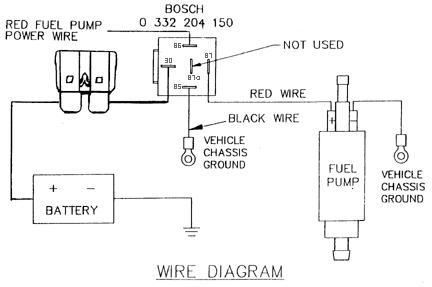
If the issue persists the problem has to be within the ECU (unlikely), in addition see my email response today for an offer of futher support
Time to step back and think about this logically, I'd also recommend stepping away from the immobiliser as it seems to be a Red Herring.
Three simple steps:
1. Tap into the power feed to the ECU with your multimeter and observe the reading when you turn the ingintion on
2. If you see the same delay, which I suspect you will, your best/easiest option would be to create a new clean switched live to the ECU
3. Use a relay for this triggered by your ignition switch (igition on terminal, possition one)
Use a diaode protected relay and replace the fuel pump in the following diagram with ECU.

If the issue persists the problem has to be within the ECU (unlikely), in addition see my email response today for an offer of futher support

Evening all,
Been exercising the multimeter again. I pulled the plug off the top of the ECU and linked a bit of wire from the plug power connection (3B?) to the multimeter, and earthed the other probe on the gearstick.
Ignition on and immediately I've got a voltage reading. No delay, instant voltage.
The voltage was low, about 6-8 volts, but I had some really dodgy connections between the plug and the meter and the earth so suffered a bit of drop there I'm sure.
So given I have power to the ECU plug, could the Canems be the problem itself? How would I know - take it off and feed it directly with 12v and see if the light comes on?
We are closing in on this issue - thanks for the advice
Chris
Been exercising the multimeter again. I pulled the plug off the top of the ECU and linked a bit of wire from the plug power connection (3B?) to the multimeter, and earthed the other probe on the gearstick.
Ignition on and immediately I've got a voltage reading. No delay, instant voltage.
The voltage was low, about 6-8 volts, but I had some really dodgy connections between the plug and the meter and the earth so suffered a bit of drop there I'm sure.
So given I have power to the ECU plug, could the Canems be the problem itself? How would I know - take it off and feed it directly with 12v and see if the light comes on?
We are closing in on this issue - thanks for the advice
Chris
Little_Blue_Car said:
Ignition on and immediately I've got a voltage reading. No delay, instant voltage.
That's a worry, seems to point to either an ECU or more likely a supply voltage issue 
Little_Blue_Car said:
The voltage was low, about 6-8 volts, but I had some really dodgy connections between the plug and the meter and the earth so suffered a bit of drop there I'm sure.
Before you go any further I would earth your meter back to the battery and ensure a better connection at the ECU plug, however if you get the same 6-8 volts reading after that you definitely have a voltage drop somewhere in the ECU supply circuit. According to the spec sheet the Canems ECU will operate within a power supply range of 7v to 18V so if your readings are correct you could potentially be at the bottom end or even outside of the voltage the ECU needs to function correctly.Don't forget you can connect your laptop to the ECU and the Canems software will tell you the voltage the ECU is receiving, just click 'VIEW' then 'INPUT DATA' , I have found this figure to be consistently lower than battery voltage by 0.5v. While it has a pretty broad operating range there's no question the ECU will greatly benefit from a solid reliable power supply, wiring it directly to the battery would give you this because of course your battery is the power supply source.
As we know the best way to give anything switched a direct supply from the battery is to use a relay and switched by low amp trigger circuit, as soon as the relay is triggered say via your ignition switch the ECU will be directly connected to the battery and so will enjoy full uninterrupted battery voltage. In theory a latching relay would be ideal, a latching relay removes the need for the trigger coil in the relay to remain permanently energised to complete the high amp battery supply circuit as is the case with a regular relay.
As you've discovered the way the system has been wired by the installers you can completely remove what Canems describes as the 'Main Relay' and the ECU will still become live when you cycle the ignition key, the only thing that actually gets disabled with no 'Main Relay' fitted is a fuel pump. Thankfully the ECU supply is still protected via fuse 12 in the ancient and corrosion prone TVR fuse board so I suspect this may be your issue, so clearly it's worth pulling fuse 12 and testing the voltage there using your multimeter.
Record and confirm back your voltage readings at these points:
1. Battery voltage - This is your control
2. Voltage to ECU measured at the ECU connector as before but earthing your meter to the battery this time and ensuring both connections are good
3. Plug you laptop into the ECU and record the voltage shown in 'INPUT DATA'
4. Check the voltage at fuse 12
Good luck with it Chris, and don't forget let us all know what you find.
Dave.
More readings for you chaps...
So:
1. battery voltage was 12.2v (now on charge)
2. voltage at fuse 12 was 12.1v
3. voltage at pin 3B was 12.1v
connected the battery live to pin 3A and voltage was 12v
Am I safe to assume therefore that the ECU is getting the necessary juice and the earth is also good?
Does that then point to a faulty unit? or should I take it out and run 12v across 3a and 3b to see if it turns on immediately before jumping to that conclusion?
Other interesting findings. My gear knob is a terrible place to earth to - anything between 4 and 8 volts seen on the meter when using it as the earth. I had assumed it would be well earthed?
I also stuck a fuse in position 21. Nothing happened...yet...but there is 12v there. Manual just says "battery feed to ignition" so does this mean it's been bypassed if all was working ok without a fuse in it? either way putting the fuse in hasn't fixed my ECU issue.
Think this has me beaten
So:
1. battery voltage was 12.2v (now on charge)
2. voltage at fuse 12 was 12.1v
3. voltage at pin 3B was 12.1v
connected the battery live to pin 3A and voltage was 12v
Am I safe to assume therefore that the ECU is getting the necessary juice and the earth is also good?
Does that then point to a faulty unit? or should I take it out and run 12v across 3a and 3b to see if it turns on immediately before jumping to that conclusion?
Other interesting findings. My gear knob is a terrible place to earth to - anything between 4 and 8 volts seen on the meter when using it as the earth. I had assumed it would be well earthed?
I also stuck a fuse in position 21. Nothing happened...yet...but there is 12v there. Manual just says "battery feed to ignition" so does this mean it's been bypassed if all was working ok without a fuse in it? either way putting the fuse in hasn't fixed my ECU issue.
Think this has me beaten
Gassing Station | Griffith | Top of Page | What's New | My Stuff






